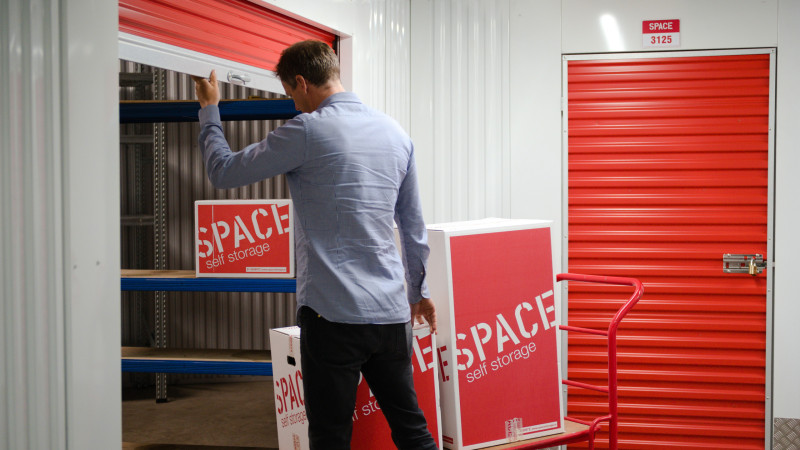Renting a self storage unit can be a game changer when it comes to freeing up space in your home, organising your belongings, or keeping things safe during a move or transition.
However, many people make the mistake of simply packing their unit full without thinking about how to maximise the space and keep things organised. Without a proper plan, it’s easy for your storage unit to become cluttered, making it hard to find things when you need them or even damaging your items.
To ensure you make the most of your storage unit and keep everything in tip top condition, here are some practical tips to help you organise, protect, and access your belongings with ease.
Choose the Right Size Unit
One of the first steps to getting the most out of your storage unit is choosing the right size. It’s important to select a unit that’s large enough to store all your items but not so big that you end up paying for unnecessary space. If you’re storing just a few boxes and small furniture pieces, a smaller unit might be enough. On the other hand, if you’re planning to store larger items like appliances, furniture, or even seasonal gear, you’ll need to go up a size.
Make an inventory of everything you plan to store before renting the unit to help you get an idea of the right size unit for your needs.
Create an Organised Layout
To maximise your storage unit, organisation is key. Instead of randomly stacking boxes and furniture, create a layout that allows for easy access and maximises vertical space. Start by placing larger, heavier items such as furniture or appliances toward the back of the unit, and stack lighter, smaller boxes on top.
Leave a pathway down the middle or on one side of the unit so you can easily walk through and access any item. If you’re using shelves, place frequently used items at the front and the less important ones toward the back.
Label Everything Clearly
It may sound obvious, but labelling your boxes properly will save you a lot of frustration when it comes time to retrieve something from your storage unit. Clearly write the contents of each box on multiple sides, so you can identify items without having to move everything around.
If you’re storing a lot of boxes, you may also want to create an inventory list. This list can include what’s in each box, which section of the unit it’s stored in, and any other relevant information. This way, you’ll know exactly where to look when you need to find something.
Use Shelving to Maximise Vertical Space
Most storage units have high ceilings, giving you the chance to take advantage of vertical space. You can maximise storage efficiency by bringing in some sturdy, adjustable shelving units. Shelves allow you to neatly stack boxes or other items without worrying about crushing things underneath heavier objects.
Using shelves also makes it easier to access what you need without having to unstack and restack everything in the unit. It’s especially helpful for keeping smaller, fragile items safe and accessible.
Disassemble Large Furniture
To make the most of your storage space, disassemble large furniture items whenever possible. This applies to beds, tables, bookshelves, and even some chairs. Breaking down furniture into smaller components means you can stack or store them more efficiently, saving valuable floor space.
When disassembling furniture, store all screws, bolts, and small parts in labelled plastic bags and tape them securely to the piece they belong to. This will prevent you from losing important parts when it’s time to reassemble your furniture.
Use Quality Packing Materials
The way you pack your items will directly impact their condition when it comes time to retrieve them. Investing in high quality packing materials can help protect your belongings while they’re in storage. Use sturdy boxes that are the same size for easy stacking, and avoid overloading them to prevent damage.
Store Items Strategically
When placing items in your storage unit, think strategically about how you arrange them based on how often you’ll need to access them. Items that you’re likely to need more frequently, like seasonal clothes or holiday decorations, should be placed toward the front of the unit for easy access.
Less frequently used items, such as furniture or off season sports equipment, can go toward the back. Organising your storage unit in this way will save you time and effort when you need to find something quickly.
Use Clear Plastic Bins for Visibility
While cardboard boxes are the go to for most storage, using clear plastic bins can be an even better option, especially for smaller items. These bins allow you to easily see the contents without having to open each one, saving you time when you’re looking for something specific.
Clear plastic bins are also sturdier than cardboard boxes, offering better protection from moisture and wear over time.
Avoid Storing Prohibited or Perishable Items
While self storage units can house a wide range of belongings, there are some items you should never store, such as food, plants, or hazardous materials. Food and perishables can attract pests, while hazardous materials (like flammable liquids or chemicals) pose safety risks.
Always check with your storage provider about what is and isn’t allowed in your unit, and avoid storing anything that could cause damage to your belongings or others around you.
Make the Most of Your Space
A self storage unit can be a valuable extension of your home, offering the extra space you need to keep your belongings safe and organised. By following these tips—choosing the right size unit, packing strategically, and staying organised—you can make the most of your storage unit and ensure that your items are easily accessible when you need them.
Whether you’re using the unit for a short term move, seasonal storage, or long term decluttering, a little planning goes a long way in getting the most out of your self storage experience.

